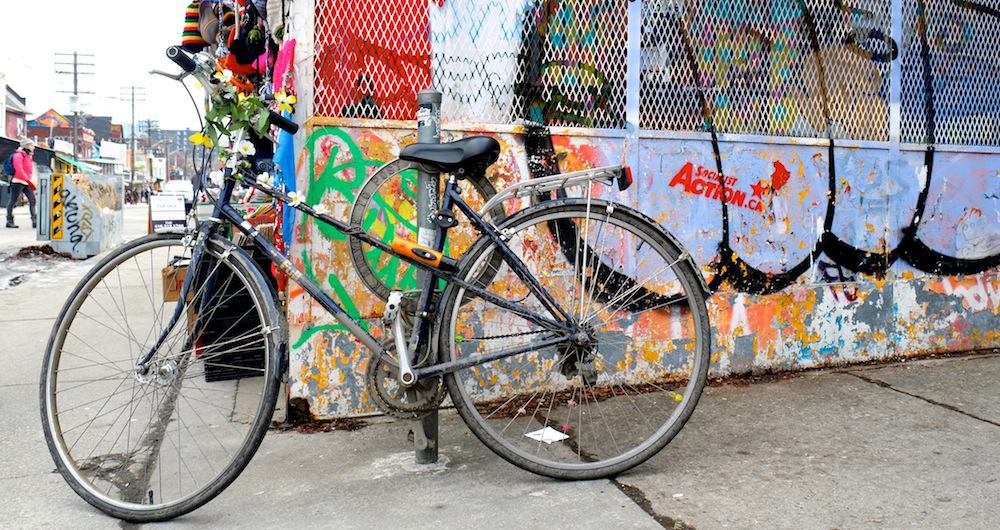An orchestra of bells, baskets, and bolts echoes in the streets of Toronto as cyclists sight-read the white painted lines on the asphalt and improvise in response to the clunking of streetcar tracks and shutting of taxi doors.
The bicycle, a single frame on two wheels, is an inexpensive, environmentally friendly and convenient mode of transportation in a congested city like Toronto. However, dwindling support for implementation and improvement of necessary infrastructure limits the growth of the city’s cycling community.
Biking in Toronto is a relatively up-and-coming phenomenon. The first bike path in the city, the Beltline Trail, was reluctantly built in the shadow of the Belt Line Railway when it halted operation in the early 1970s. The first marked bike lane was not installed until the late 1970s under the supervision of Parks Commissioner Tommy Thompson. It was not for another 40 years that the first separated bike lane was built in 2012, running north-south on Sherbourne Avenue.
A bicycle friendly city?
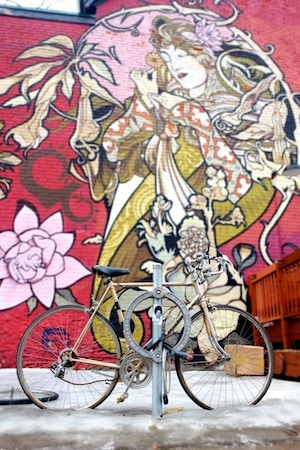 The Toronto City Cycling Committee was founded in 1975 to encourage biking and bike safety. In 2001, the Toronto Bike Plan was established by City Council to promote cycling and reduce injury. In the plan overview, the initiative sought to achieve these goals with a view towards actualizing “a vision of a more Bicycle Friendly City” by both managing “existing programs and infrastructure” and fostering “new and or improved cycling programs and facilities.”
The Toronto City Cycling Committee was founded in 1975 to encourage biking and bike safety. In 2001, the Toronto Bike Plan was established by City Council to promote cycling and reduce injury. In the plan overview, the initiative sought to achieve these goals with a view towards actualizing “a vision of a more Bicycle Friendly City” by both managing “existing programs and infrastructure” and fostering “new and or improved cycling programs and facilities.”
These goals have not been entirely achieved, however. There is currently a staggeringly small number of bike lanes in the city, with 110 kilometres of urban bike lanes in a city with 5,617 kilometres of road.
Even though Toronto has North America’s third largest public transportation system, cycling infrastructure is virtually non-existent, even at a time when bike culture is rapidly expanding. In recent years, three bike lanes were removed on Pharmacy, Birchmount, and Jarvis.
Safety is also a concern. From 1986 until 2010, there were 31,481 bicycle collisions reported in Toronto, some of which resulted in major injuries and fatalities. Overall, however, few cyclists are involved in collisions annually in Toronto, with just 1,200 reported incidents per year. However, this number has not improved in recent years, and many collisions are not reported.
Cycling culture

The number of people riding bikes in Toronto increased by 30 per cent from 2001 to 2006, and continues to rise — an effect of cycling becoming much more than a means to commute in the city. Cycling is now invested with a growing downtown community of green, health-conscious people of all ages.
Group rides organized by organizations such as Chain Reaction and Dark Horse Espresso Bar gather cyclists together to rove the city with like-minded company. Various blogs are dedicated to cyclist culture, showcasing the street style of cyclists and recent technology and gear, such as bikingtoronto.com, which includes events listings and lively discussions and 416cyclestyle.com. iBikeTO.ca is a community-run blog run by Herb van den Dool, a Toronto cyclist. This site includes a map feature called “Ride the City,” also available as an iPhone app, which searches for the safest or most direct bike lane route to your destination. Dandyhorse is a print-based magazine dedicated to cycling in Toronto. Various eclectic bike shops in the city also serve the cyclist community.
Young people are among those joining in on this culture, as busy students lugging books and bags use the bike as a mode of commuting and running their errands. Saving on the cost of a transit pass also entices students to employ bikes for transportation. BikeChain, a levy-funded service offered at U of T, provides students with tools and education to service their bikes cheaply on campus.
Saving time and money are not the only motivating factors for students who bike, however. “Despite the lack of infrastructure, [biking] is probably the best way to get around,” suggests Alex Tizzard, a fourth-year student and cycling enthusiast in Urban Studies at the university.
He adds, “Right now… it’s obvious that cities have been built and rebuilt to accommodate the car. Now, there is an increased desire and awareness to create more complete streets… I think there needs to be more of a balance, which there clearly is not.”
Bells on Bloor
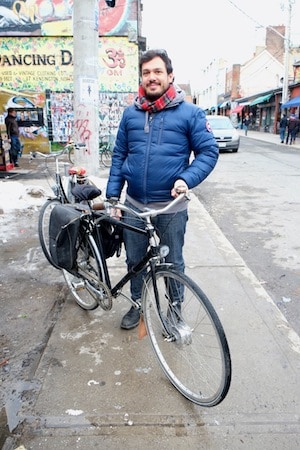 With rising popularity and a cycling community of almost 1 million people, the cycling population, although a minority, is too large to ignore. Still, cycling safety is not prioritized in municipal government, and existing infrastructure fails to create a safe environment on the road. Bikes share the road in uncomfortably close proximity with large, heavy vehicles, posing challenges to both cyclists and drivers who struggle to share lanes.
With rising popularity and a cycling community of almost 1 million people, the cycling population, although a minority, is too large to ignore. Still, cycling safety is not prioritized in municipal government, and existing infrastructure fails to create a safe environment on the road. Bikes share the road in uncomfortably close proximity with large, heavy vehicles, posing challenges to both cyclists and drivers who struggle to share lanes.
Cyclists in Toronto are in agreement that the change that needs to occur to achieve better bike infrastructure in the city is an overall increase in bike lanes. Albert Koehl is the founding member of Bells on Bloor and a board member of the Annex Residents Association. He comments, “We need a lot more bike lanes. We have 110 km of bike lane on a road system that is over 5200 km. We have virtually no bike lanes, we have no bike network at all. You can ride up and down Sherbourne, but what does it connect to?”
The lack of connecting lanes is a major issue, as there currently is no separated east-west bike lane that spans the downtown core. Koehl adds, “It’s a question of making a network and getting people to where they are going.”
Bells on Bloor advocates for an east-west route on Bloor Street as a main artery for an improved bike lane system.
Bloor Street is a continuous road with no streetcar tracks and a subway line running right under it, rendering it an ideal route for cyclists. Continuity allows for a direct route without twists and turns. The lack of streetcar tracks eliminates the risk of bike tires getting caught in the tracks, trapping cyclists in dangerous positions or swerving them off the tracks into oncoming traffic. The proximity of the subway allows commuters from the surrounding suburbs without cars to easily transport their bikes downtown.
The proposed Bloor Street bike lane pilot project would stretch from Sherbourne Street to Shaw Street, passing St. George Street. Other stretches of road in Toronto have also been suggested as potential routes for bikes, including a lane on nearby Dupont Street stretching from Dundas Street West to Yonge Street.
Resistance on City Council
Recently, the Toronto Public Works Committee approved a $450,000 environmental assessment (EA) for the proposed bike lanes on Bloor Street and Dupont Street. Although this was presented as a major development, according to Koehl, an EA is not a requirement for the construction of a bike lane.
Bells on Bloor reached out to City Council to point out this discrepancy, stating in a email that, “…the construction of a bike lane is considered pre-approved, and only requires public notification prior to implementation.”
The proposed lanes would remove two of the four car lanes on Bloor Street, replacing the twenty-four hour parking spots along the road with bike lanes. The EA will also look at the impact of implementing a Dupont Street bike lane.
An EA, which Koehl’s groups suggests is unnecessary, is an expensive study that will not begin until fall 2014 and will take a year to complete. Discussions of actually installing the Bloor Street bike lane will be delayed until 2015 as a result of this undertaking.
City councillor Mike Layton of Ward 19 Trinity-Spadina challenges this view, suggesting that an environmental assessment, which includes looking at economic and social factors, is necessary because of the many factors involved that need to studied, including the impact on local businesses and the arrangement, unidirectional or bidirectional, that would be most appropriate.
In an interview with The Varsity, Layton adds, “If you just go ahead and put a lane in, you don’t address the needs of the people.” The importance, he expressed, lies in “creat[ing] acceptance for the bike lane and support for it.”
The EA for the Bloor Street lanes was halted in 2011 when Mayor Rob Ford gained power, but as his power waned, Layton notes, “We got it back,” particularly with the push from councillor Adam Vaughan of Ward 20 Trinity-Spadina.
City councillor Denzil Minnan-Wong, chair of the Public Works Committee, is the only city councillor that voted against the EA for the Bloor Street bike lanes, stating in a council meeting that it is, “the wrong street to put bike lanes on.”
He added, “Congestion and gridlock are a real problem in this city and adding more bike lanes and decreasing capacity on an important arterial road that runs from one end of the city to another will make it even worse.” Minnan-Wong’s office declined to comment.
Layton suggests that most councillors are aware of the need for bike lanes — just not in their ward: “A councillor’s position about bike lanes has a lot to do with the area they represent.”
Loss of parking, Layton suggests, is the major source of complaints in response to bike lanes. He adds, “Bloor is a vibrant and commercial street and it depends on parking to a certain degree.”
However, Bloor West Village drivers provide only an estimated 10 per cent of business to shops and restaurants along Bloor Street. The rest of the business comes mostly from cyclist and pedestrian traffic. Layton says it’s now a matter of proving these figures to store owners that would be directly affected by loss of parking spaces.
Towards a friendlier city
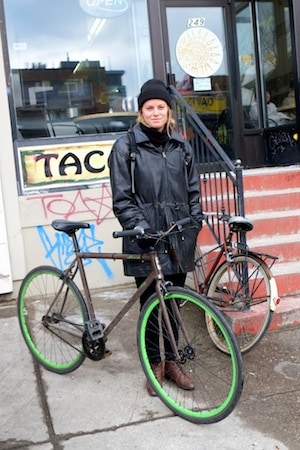 As an alternative to the EA study, Bells on Bloor has proposed a pilot bike lane project that would run the length of Bloor Street, including past U of T’s St. George campus, connecting to St. George bike lanes and increasing access to the Grace and Shaw north-south lanes. Koehl notes, “A pilot would show people what it would look like… [it’s] a way to deal with people who are fearful and reluctant.”
As an alternative to the EA study, Bells on Bloor has proposed a pilot bike lane project that would run the length of Bloor Street, including past U of T’s St. George campus, connecting to St. George bike lanes and increasing access to the Grace and Shaw north-south lanes. Koehl notes, “A pilot would show people what it would look like… [it’s] a way to deal with people who are fearful and reluctant.”
With a pilot, Torontonians can be provided with firsthand evidence of the impact of implementing the full bike lane, rather than with the expensive cost of a study that is not legally required in order to put paint to pavement.
Koehl also suggests that the study is repetitive, given that a 1992 study already deemed Bloor-Danforth an ideal east-west bike route.
Council is taking a step forward now with current plans to install a separated bidirectional bike lane on Harbord Street.
The frustration surrounding this issue among cyclists, advocates, and councillors alike is obvious. “Putting a bike lane on Bloor is no complex thing — you paint a line and you’re done,” Koehl claims.
Layton contends, however, that the addition of the bike lane requires careful consideration. The strongest consensus in the bike lanes debate is the necessity of improving infrastructure for cyclists. Layton suggests that Toronto would reap the benefits of bike lanes, which “help our economy, get people out of cars, alleviate gridlock, keep a healthier society, and decreases money we spend later in life because it’s an active form of transportation.”
He adds that the critical step needed in order to push the city to implement more bike lanes is to increase constituents’ enthusiasm for the project: “As more people look into cycling as a more feasible way of transportation in their neighbourhood, their attitudes will be changing.”
On his commute from Christie Pitts to City Hall, Layton knows it takes a fraction of the time to bike than to take the TTC to get to his workplace, and predicts it would take twice as long by car. Not only that, but, “you tend to get to work and school less stressed out [when you bike].”
Michael Ly, a second-year molecular genetics and microbiology specialist at U of T says he rides his bike “…because of the enjoyment [he gets] out of it. The fresh summer wind blowing on your face and the freedom to perform any maneuver are examples of reasons why bike riding is incomparable to other methods of transportation.”
Despite safety concerns and the lack of bike lanes, dedicated cyclists will continue to fight for their place on Toronto’s streets. Toronto will be a friendlier, more harmonized city when all modes of transportation are accommodated. With the implementation of carefully planned bike lanes, rather than endanger one another, cyclists, pedestrians, and vehicles alike will be able to safely share the road in Toronto.
Tizzard reflects, “Both cars and bikes have their place in the city. It’s about creating streets that accommodate [both].”
Read our guide to biking through the winter.
Toronto’s bike lanes
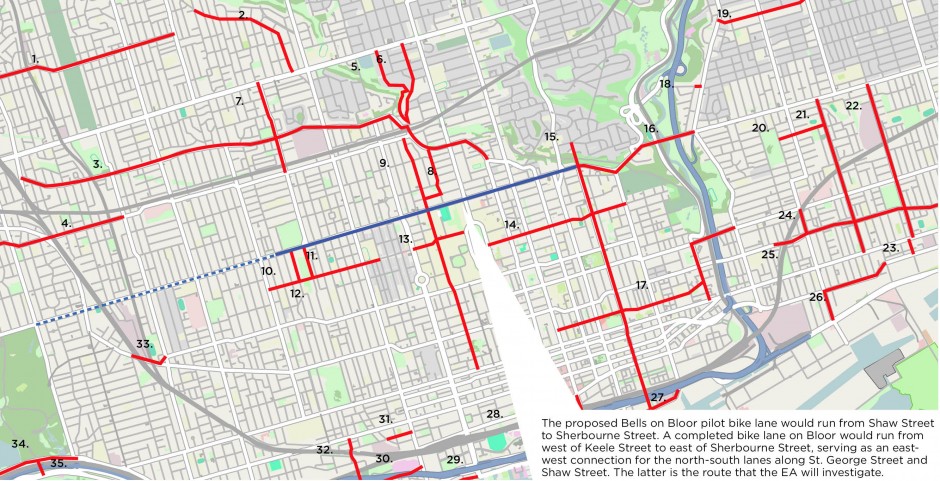
1. Rogers Road: Old Weston to Oakwood, 2.44 km
2. Vaughn Road: Winona Drive to St. Clair West, 1.65 km
3. Davenport Road – Old Weston to Bay & Yorkville, 6.44 km
4. Annette Street: Jane Street to Landsdowne Avenue
5 & 6. Russel Hill / Boulton / Poplar Plains: St. Clair to MacPherson, 2.27 km
7. Christie Street: St. Clair to Dupont, 1.17km
8. Bedford Road / Prince Arthur Avenue: Davenport to St. George & Prince Arthur, 794.38 m
9. St. George Street / Beverly Street: Dupont to Queen, 3.04 km
10. Montrose Avenue: Harbord to Bloor, 400 m
11. Grace Street: Bloor to Harbord, 400 m
12. Harbord Street: Ossington to Borden, 1.43 km
13. Harbord Street / Hoskin Avenue: Spadina to Queens Park, 681.65 m
14. Wellesley Street: Queens Park to Parliament, 1.79 km
15. Sherbourne Street: Elm to Queens Quay, 3.5 km
16. Bloor Street E: Sherbourne to Broadview, 1.8 km
17. Shuter Street: Yonge to River, 1.93 km
18. Chester Hill Road: Cambridge to Broadview, 96.61 m
19. Cosburn Avenue: Broadview to Haldon, 3.73 km
20. Strathcona: Carlaw to Jones, 568.98 m
21. Jones Avenue: Danforth to Queen, 2.01 km
22. Greenwood Avenue: Danforth to Queen, 1.95 km
23. Knox Avenue: Queen to Eastern, 191.31 m
24. Carlaw Avenue: Gerrard to Dundas, 300 m
25. Dundas Street E: Broadview to Kingston, 3.4 km
26. Eastern Avenue and Logan Avenue: Leslie to Lakeshore, 1.5 km
27. Yonge and Queens Quay: Front to Parliament, 1.86 km
28. Simcoe Street: Front to Bremner, 276.06 m
29. Queens Quay: Stadium to Spadina, 827.19 m
30. Fort York: Lakeshore to Bathurst, 704.93 m
31. Wellington Street: Niagara to Bathurst
32. Strachan: King to Lakeshore, 856.97 m
33. Dundas Street W and College Street: Sorauren to Landsdowne, 484.72 m
34. Queensway / Stephan: Stephan to Claude
35. Colborne Lodge Drive: Queensway to Lakeshore, 206.12 m

